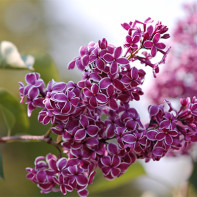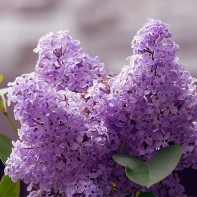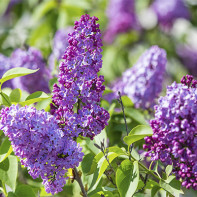Lilac: medicinal properties and contraindications
Lilac is a plant with small but very fragrant flowers. It is very popular and loved all over the world, it is praised by poets and writers. In many paintings you can find its image. Modern designers and ordinary gardeners use the shrub to decorate the landscape of city streets and personal home areas.
- Chemical composition
- How it looks and where it grows
- Types
- Collection and storage
- Omen and beliefs associated with lilacs
- Lilacs medicinal properties
- Lilac in folk medicine
- Tincture for the treatment of joints
- Tincture for rheumatism
- Remedy for colds
- Decoction for lowering blood sugar
- Remedy for pyelonephritis
- Tincture for skin diseases
- Tincture for Gout
- Barley Treatment
- Tincture for varicose veins
- Eye Treatment
- Healing preparations
- Tincture
- Tincture
- Decoction
- Tea
- Salve
- Lilac oil: properties and uses
- Cosmetic applications
- Lotion Recipe
- Hand and nail care product
- Lotion against cellulite and flabbiness
- Hair Care
- How Lilac is Cooked
- Is lilac jam useful?
- Can we give lilacs to rabbits?
- Contraindications for use
Chemical Composition
Different parts of the plant contain certain chemicals. For example, lilac flowers are dominated by alkaloids, essential oil, farnesol. The buds and leaves contain chemical elements such as flavonoids, phytoncides, phenol glycoside syringin, coumarin derivatives, tannins, resins and ascorbic acid.
What it looks like and where it grows
Lilac is a shrub that belongs to the Olive family. Its closest relatives include ash, turquoise, jasmine, and olive.

The bush refers to perennial plants. It usually consists of several trunks, 5-8 m high, which grow upright or spread out. The foliage is dark green and evenly spaced throughout the shrub. The first leaves begin to appear in early to mid spring, depending on the region of growth. Leaf fall occurs before the first frosts, tentatively in October or November. Each leaf is a separate leaf plate which can grow to a length of 12 cm. The shape can vary depending on the species: oval, cone-shaped, pinnate, etc.
Lilac flowers are funnel-shaped and most often end in 4 petals. Sometimes 5 and 6 petals are found. The small flowers are arranged close to each other and thus look like a massive cluster. The colors are quite varied, ranging from the traditionally lilac to a rare yellow or blue.
During flowering, lilacs exude a delicate, sweet and quite persistent fragrance to the whole neighborhood. It blooms annually from late April until early June.
The shrub is native to hot Africa. Its main territorial habitat is China, the Far East and the European southern mountains. It is believed that it was in China that the lilac was first cultivated. It came to Russia in the early 19th century during a siege of a Swedish fortress and gradually spread throughout Russian soil.
The shrub is so beloved and popular that breeders from all over the world continue to work on breeding new varieties. Today, there are about 30 species of lilacs in nature that grow throughout European territory.
Species
Consider the most popular species of the fragrant plant today.
Common lilac.
The most common representative. In the natural environment is most often found in the Carpathians. Cultivated brethren are scattered around the world. Externally it is a shrub of several trunks. The average height can vary from 2 to 8 m. The color of the bark and the adult trunk is gray-brown, with a greenish hue on the young shoots. Leaves are large, heart-shaped, reaching a length of 12 cm and a width of 8 cm. A characteristic feature of the leaf is that it remains green until late fall, when falling, the color does not change.
The color of the flowers depends on the variety, but to a large extent prevails lilac, white and purple. The flowering period begins in mid-May and lasts 20-25 days. The shrub endures both frost and drought well, it is not fastidious to the soil. But when planting it is worth taking into account that the root system grows quickly.
Hungarian
From the name it is clear that the homeland of this species is Hungary. Unpretentious, feels normal even in harsh climates. The maximum height of the shrub does not exceed 4 m. Distinguished by the rapid growth, but when reaching the specified maximum stops growing.
The shoots are straight, with a characteristic neat crown. Root shoots are absent. Unlike other representatives, the leaves, about 12 cm long, are drooping downwards. By spring, the color of the leaf changes from green to yellow. This species is very beautiful during the flowering period, which begins in early June and lasts 25 days. Hungarian lilacs have a pleasant subtle fragrance. The range of colors is very diverse.
The ideal place for planting will be an open bright place. Badly tolerates winds and waterlogged soil.
Sensation
This species was bred by French breeders and is considered one of the youngest. It is very popular in Russia. A distinctive feature is the bicolor color of the flowers and the magnificent, incomparable smell.
The size of the shrub can reach 3 m both in height and width. Grows about 20 cm per year. Shoots are erect. The leaf is large, green in color. Flowering occurs in late spring and lasts up to 3 weeks. This species is frost-resistant. Prefers to grow in full sun or moderate penumbra.
Meyer's
A dwarf shrub, its height does not exceed 1.5 m. It grows very slowly. Leaves are small - only 4 cm, dark green in color. Flowers are small. Depending on the variety, the colors can be purple, white, lilac, and sometimes red. Blossoms, as a rule, in early June. But there are often repeated blooms in late August.
Persian
This species predominates in Japan, Turkey, Afghanistan, the Crimean Peninsula, and the Caucasus. In most of the Russian Federation it does not grow under natural conditions. But most nurseries and research institutes at botanical gardens cultivate the shrub by means of selection. Requires a lot of attention. Costs a lot, so not everyone can afford to decorate the area around the house with this species.
Grows quickly, the maximum height of 1 to 2 m. Leaves are smooth, oval-shaped, length - 2-4 cm. During the flowering period (end of May) is decorated with small purple-pink fragrant flowers. Lilacs do not tolerate damp, draughts and darkened places.
Primrose .
Was bred in the middle of the twentieth century by breeders from Holland. The difference is the rare color, mostly yellow. Grows to 3.5 m, adding 30 cm annually. The leaf is heart-shaped and 4 to 12 cm long.
In mid-May yellow flowers appear on the lilacs, which gradually burn out and become yellowish-white in color. Attracts the attention of everyone in the area not only with its unusual color, but also with its delightful fragrance.
Specialists recommend planting this species in mid-summer in bright areas. The plant does not tolerate wind and excessive moisture.
Amur
From the name it is clear that the area of growth is the Amur region, the Far East, the eastern part of China. It's a luxurious shrub-tree, reaching 20 m in height. It's distinguished by extremely slow growth but longevity. In the nature there are specimens that live about a century. The leaf is large, changing color from green to gold by the fall. The flowers are small, most often white. Flowering begins at the end of June and lasts several weeks. Emits a pleasant fragrance that attracts not only many insects but also people.
Stem lilacs
The shrub is about 2 m tall. A characteristic difference from other species is the presence of flowers of different shades on a single specimen. The trunk is straight, resembling a cane. The leaves are small. Does not like groundwater and acidic soil. In the rest is not fastidious. Stem lilacs are often used in landscape design as a separate display or as part of a particular composition.
Indian Lilac.
The most unusual species, which has about 25 subspecies. It came to Europe from Asia at the beginning of the 18th century and instantly became popular. In natural environment, the height of the shrub reaches 9 m, and the width can reach up to 8 m. A feature is the long period of flowering - from early summer to mid-autumn. At this time, the shrub is covered with a huge number of flowers of different shades. The flower itself resembles a velvet rose in miniature. Such beauty will not leave anyone indifferent.
The shrub is heat-loving, but can withstand frosts down to -15°C. In Russia, it is most commonly found in southern areas. This species can be grown and kept in room conditions.
Palibin .
The difference from other species is the annual double flowering: the first time in May, the second - in August. The height of the shrub does not exceed half a meter. The leaf is less than 4 cm. Flowers are small, pale lilac shade. It is very important to prune at least once a year. This procedure contributes to abundant flowering in the next period.
Gathering and storage
In order to get the most out of lilacs, it is important to properly collect and store the plant.
As a rule, buds, leaves and flowers are used. The leaves are collected from mid-May to the end of July. Buds and flowers are collected during flowering. The drying method for various parts may vary. For flowers, whole branches are cut off, shaped into bunches and hung upside down in a dark, well-ventilated room. Leaves are separated from the branches, put in a dryer with a pre-set temperature of 40-60°C. If there is no special device, you can dry the leaves in the sun.
Store the finished raw material is recommended no more than 2 years.
Odds and beliefs about lilacs
- As a rule, each lilac flower has only 4 petals. It is extremely rare to find 5 or more. It is with this that the first omen is associated. It is believed that if a person manages to find a five-petal flower in a bouquet of lilacs, then the wish will certainly come true. But only on the condition that the flower will be eaten.
- From ancient times, this shrub is considered a talisman. Our ancestors believed that if you plant a lilac near the house, then bad luck will bypass all family members living within these walls. By the way, based on the opinions and reviews of people on the Internet, many still continue to believe in this omen.
- It is believed that white lilacs are able to attract well-being and prosperity for their owners. In addition, if a plant that is in the yard is well visible to passers-by from the street, then the household can not fear the spoilage and evil eye of ill-wishers.
- There is a belief that, being near a fragrant shrub and feeling its delicate sweet smell, people of creative professions can feel a burst of additional inspiration. If a person has hidden talents, of which even he himself does not suspect, then the time spent near the shrub can contribute to their disclosure.
Believe or not in omens and beliefs associated with lilacs is a personal matter for everyone. But you should not refute the long-standing evidence that the flowers and leaves of this shrub can have a beneficial effect on the human body and help in the treatment and prevention of many diseases.
Therapeutic properties of lilacs
Lilac is actively used both in traditional medicine and in folk medicine. In addition, due to its chemical composition, it is widely used in cosmetology and perfumery.
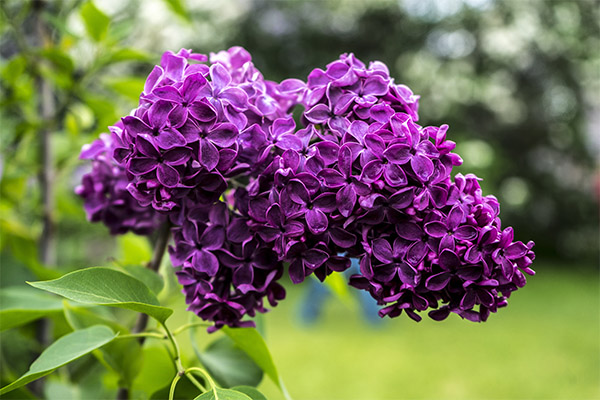
There are the following medicinal properties of this perennial plant:
- It has an anti-inflammatory effect on the human body.
- It has an antipyretic effect.
- It is a strong diaphoretic.
- Has an analgesic effect.
- Helps with diseases associated with problems of the genitourinary system.
- Used as an antimicrobial and antibacterial agent.
- Normalizes the level of cholesterol and blood sugar.
- It has a positive effect on the cardiovascular and digestive systems.
- Normalizes blood pressure and improves metabolism.
- Relieves inflammation in the joints.
- Relieves muscle pain.
- A beneficial effect on the nervous system.
Lilac in folk medicine
Folk healers are very fond of using lilac in various healing remedies for many ailments. Consider the most popular recipes.
Tincture for the treatment of joints
To prepare this remedy, you will need 2 tablespoons of dried flowers and 200 ml of vodka. If necessary, the recommended alcohol can be replaced with 70% medical alcohol.
Fill lilacs with the required amount of alcohol-containing liquid, close the container tightly. Take in a dark cool place for 14 days. Important point - during infusion, the remedy should be shaken daily. Apply the tincture inside by teaspoon 3 times daily 30 minutes before a meal. The course of treatment - from 2 to 6 months.
Tincture for rheumatism
Ingredients:
- 2 tablespoons of lilac flowers;
- 100 grams of vodka.
Pour dry raw materials with vodka. Insist 2-4 hours, then strain. Apply only externally, rubbing it into the sore spots several times a day. A compress can be made at night. Use until completely cured.
Remedy for colds
To prepare a healing remedy for a cold, you need to mix 30 g of lilac buds and flowers with 20 g of linden flower. The resulting herbal mixture pour 500 ml of boiling water. Boil over low heat for 20-30 minutes. Remove from the heat, cover tightly and allow to stand for several hours.
Strain, then apply internally 3-4 times a day for 50 ml. This decoction is excellent for all colds and viral diseases, has antipyretic, anti-inflammatory properties.
Decoction for reducing blood sugar.
You will need 20 g of dried lilac buds. They should be placed in a small saucepan and pour one glass of water. Boil on a water bath for 10 minutes, cool, strain, bring the resulting volume to 200 ml.
It is recommended to use 3 times a day with a tablespoon. The course of treatment is 14 days. If necessary, you can repeat the treatment after a month.
Remedy for pyelonephritis
This infusion helps very well with pathologies of the urogenital system and is a therapeutic and preventive agent in the treatment of urolithiasis.
Ingredients:
- Crushed dried lilac leaves in the amount of 2 tablespoons;
- 250 ml of hot water.
Pour water over the leaves, bring to a boil, but do not boil. Insist for 2-3 hours. Strain, apply internally 3 times a day before meals. The dosage - 2 tablespoons at one time.
Infusion for the treatment of skin diseases
Very often there are various problems with human skin - dryness, irritation, rashes. All this will not give beauty to the external appearance. In order to quickly give the skin a healthy appearance, you can use a lilac infusion. It is not difficult to prepare, and the result will please you.
In a bowl, preferably enameled, pour the finely chopped fresh lilac leaves. Add one glass of water, put on a small fire and bring to a boil. Leave to infuse for a few hours and strain.
Use to wipe and apply lotions to the affected areas of the skin. The duration of treatment is set individually until the complete elimination of the problem.
Tincture for gout
With gout, the tincture can have not only a preventive effect, but also a therapeutic effect. The remedy is excellent in the treatment of this ailment. Its preparation will require 2-3 tablespoons of crushed lilac leaves in dry form and 100 grams of vodka. Pour the plant alcohol, insist in a dark place for 14-20 days. Before use, strain.
The recommended daily dose is 75 drops. They are divided into three equal parts of 25 drops at a time and apply 3 times a day. Interval between doses is at least 4 hours. The course of treatment lasts 21 days. Then it is necessary to take a twenty-day break. The next course lasts for two weeks. The dosage should be as follows: 20 drops 2 times a day, in the morning and in the evening.
Treatment of barley
From such an unpleasant ailment as a barley, a common lilac will quickly help to get rid of it. The folk recipe is as follows: pick a few lilac leaves, rinse them thoroughly and grind them to a mushy state. Put it on a whole, preferably large, leaf and apply it to the barley.
According to numerous reviews, this procedure is a very effective way of treatment. Many note that with five times daily application, inflammation decreases already by the end of the first day.
Tincture for varicose veins
To prepare a remedy that effectively gets rid of varicose veins, you will need not only lilacs, but also several other plants.
Ingredients:
- lilac, acacia, and lily flowers in the following quantities 200:100:200 g;
- 1 l of vodka.
Preparation:
- 200 g of lilac flowers pour 1 liter of vodka. Insist for 10 days in a dark cool place.
- On the eleventh day add to the lilac tincture 100 grams of white lily. Then it needs to be kept in a dark box for 10 days more.
- At the end of this time add flowers of acacia. After a week, strain the tincture.
Means for the treatment of varicose veins ready. Store in the refrigerator no more than 30 days.
How to use
Received infusion abundantly rub the problem areas. Then wrap them with cling film and woolen cloth and leave for the night. The procedure should be performed every day for 14-20 days.
Eye Treatment
As they say, the eyes are the mirror of the soul. But in the modern world, many people, due to the specificity of work, have to spend a lot of time in front of computer screens and tablets. At the end of the day, you may see a blurred look in your reddened eyes instead of a clear vision. An infusion of lilac will help you get rid of this problem. The preparation method is very simple: pour a teaspoon of dried lilac flowers with a glass of boiling water. Cover with a lid or saucer and wait until it cools.
Apply daily in the form of compresses. The duration of one procedure - at least 10 minutes. Regular use of this remedy will not only return your eyes to their natural beauty and health, but also help maintain normal vision.
Types of healing compositions
Lilac as a healing ingredient is used to prepare therapeutic means of various compositions. In the first diseases, it is recommended to use lilac tinctures, in the second - decoctions, in the third - ointments, which necessarily include this plant.
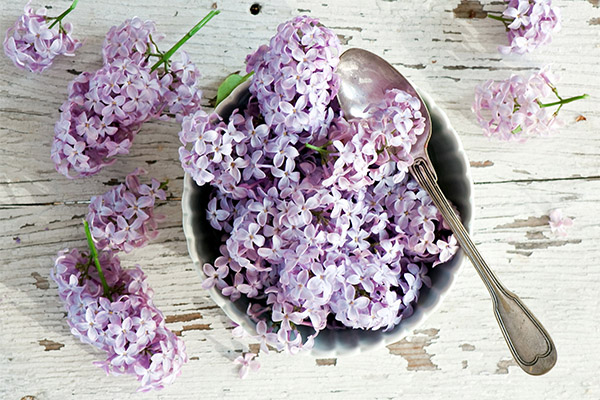
Infusion .
Infusion differs from tincture in that it does not require alcohol-containing ingredients. Most often, the cooking time does not exceed a few hours.
A classic recipe for lilac infusion
It is necessary to take a teaspoon of flowers with a handful, and there is no difference, whether they will be dry or fresh, pour a glass of boiling water. Cover with a saucer and insist for about an hour. The classic recipe is good for joint pains, bone problems, respiratory system diseases.
Tincture .
This remedy is the most popular. It is the tincture that is used for a large number of diseases, using both for internal and external treatment. In combination with alcohol-containing agents, the antibacterial effect of lilac is enhanced.
To prepare lilac tincture broad-spectrum will need 2-3 tablespoons of dry plant parts and 300 ml of vodka or medical alcohol. All mixed in a tightly closed container. Screw and put in a dark cool place for 14 days. Shake daily. After the specified period, the tincture is ready for use.
Decoction
Decoction is prepared in about the same way as the infusion. But there is a slight difference between these two miraculous remedies. To prepare a decoction, it is not enough just to pour dry raw materials with water. It is necessary to carry out heat treatment in the form of boiling for 20-30 minutes. The second difference is in the proportions. When preparing a decoction, they are slightly larger: 3 tablespoons of lilac per 500 ml of water.
The remedy has proven to be excellent in the treatment of colds. Especially effective action has a rinse with lilac decoction for sore throat.
Tea
Tea made from lilac leaves is most often used as a sedative. Rinse a few fresh leaves of the plant and pour boiling water over them. Allow it to sit and soak for 5 to 7 minutes. Use in the evening instead of the usual tea. The drink normalizes the heart rhythm, relieves insomnia, eliminates irritability and nervousness.
If you add a spoonful of honey and a slice of lemon to the tea prepared according to the above-described classic recipe, it becomes an excellent preventive measure, which simply must be consumed by everyone during the season of colds.
The ointment .
With headaches, migraines, injuries and bruises of various origins, an ointment, the main ingredient of which is lilac, helps well. Prepare it yourself at home. You will need only two ingredients: dried lilac flowers and butter.
Grind in a blender 2 tablespoons of dry raw materials to a powder state. Take the butter, in the same amount as the lilac flowers, out of the fridge. Leave it on the table until it acquires a soft texture in natural conditions. Combine both products and mix thoroughly. Store the resulting ointment in the refrigerator.
Apply externally, rubbing the injured places. For headaches, the ointment is rubbed into the back of the head and temple.
Lilac oil: properties and uses
Lilac oil is characterized by a sweet aroma, the inhalation of which reduces any nervous tension, disappears depression, there is a sense of newness. Such influence on the human emotional state is not accidental. After all, it is this shrub that most people associate with the beginning of spring, and therefore the awakening of life.
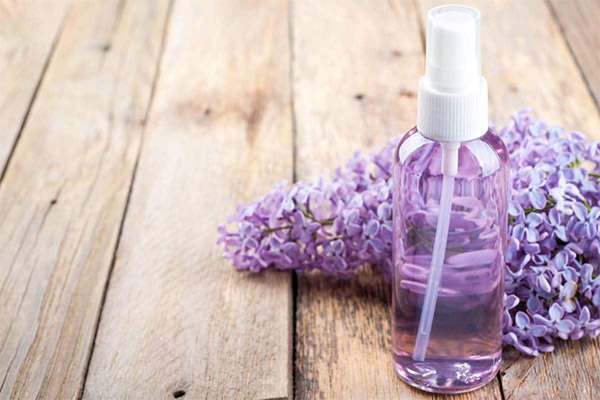
The benefits of lilac oil are undeniable. Even our ancestors used it to treat many ailments. The oil is most often used for aromatherapy procedures, or as a base for massages.
You can buy the ready-made oil in pharmacy chains and specialized cosmetic stores, or you can make your own. You will need fresh lilac flowers, any odorless vegetable oil, a liter container, gauze.
- Separate the flowers from the branches. Carefully fill the container with them.
- Heat the oil to a temperature of 40°C. Carefully pour it into a container with the lilacs.
- Put in a dark place for a few days.
- Strain the oil, squeeze out the already used flowers and throw them away.
- Fill a container with new flowers and pour the strained heated oil.
All steps should be repeated at least 5-6 times. This is the only way to get high quality and fragrant lilac oil.
Lilac oil has the following properties:
- soothing;
- antipyretic;
- analgesic;
- antibacterial;
- wound-healing.
The oil, like the ointment, helps effectively fight headaches and joint pains. This product is often added to your favorite creams and shampoos. Products will not only acquire an additional delicate fragrance, but also will be saturated with useful substances. Aromatherapy with lilac helps to combat stress, increases libido. Fill your home with the scent of spring, you can add a few drops of oil to the cleaning water.
Cosmetological applications
Lilac, most often in the form of oil, is actively used in cosmetology. Thanks to its wound-healing properties and its ability to combat skin problems, lilac extract is added to various cosmetic preparations, as well as to hygiene products: bath salts, liquid soaps, etc. This ingredient can be added to masks, lotions and creams, prepared independently at home.
Lotion recipe
Mix a tablespoon each of lilac flowers, chamomile and witch hazel. The resulting mixture pour 500 ml of boiling water and leave until completely cooled. Then strain and add a few drops of orange essential oil and a teaspoon of aloe juice. Stir well. Rub the face daily after cleansing in the morning and evening. The lotion tones and regenerates the skin.
Hand and Nail Remedy
For preparation you will need lilac, celandine, rose hips (fruits) one teaspoon each. Grind three kinds of plants with a blender. Add a dessert spoonful of glycerin (sold at the drugstore) and 3 tablespoons of vegetable oil of choice: linseed, olive, almond oil. Container tightly closed and put in a dark cool place for a week. At the end of the specified time, strain. Lubricate hands and nails daily before going to bed. This remedy moistens the skin of the hands and strengthens the nail plates.
Lotion against cellulite and body laxity
Ingredients:
- One cup apple cider vinegar;
- 1 teaspoon pepper tincture;
- 1 tablespoon of lilac oil;
- 1 tablespoon of freshly squeezed lemon juice.
Mix all the above ingredients thoroughly. Apply in several ways:
- Rub into problem areas with massaging motions by hand or with a massager.
- Use as a base for wrapping. Apply liberally to the areas of the body requiring correction, and wrap in cling film for half an hour. Take a contrast shower and apply moisturizing cream.
To enhance the anti-cellulite effect of both methods it is recommended to take a warming bath and a body scrubbing procedure beforehand.
Hair product
Can be used as a rinse after washing your hair. To prepare it, pour 3 tablespoons of dried lilacs with a liter of boiling water, cool and strain. Miracle rinse is ready.
You can prepare a healing mask. This will require: burdock oil - 2 tablespoons, lilac tincture - a teaspoon, an ampoule of vitamin A, which can be purchased in pharmacy chains. Mix everything and apply to the scalp with massaging movements. Wrap your head with a towel and leave it for 40 minutes. Wash your hair as usual, using your usual shampoo.
Lilac remedies have a beneficial effect on the scalp and hair. With regular use, the described procedures restore the water-fat balance of the skin, and also help to combat dryness and hair loss.
How Lilac is used in cooking
In cooking, lilac flowers are most often used to prepare desserts. One of the most popular sweet dishes is lilac ice cream, which was first made over a hundred years ago.
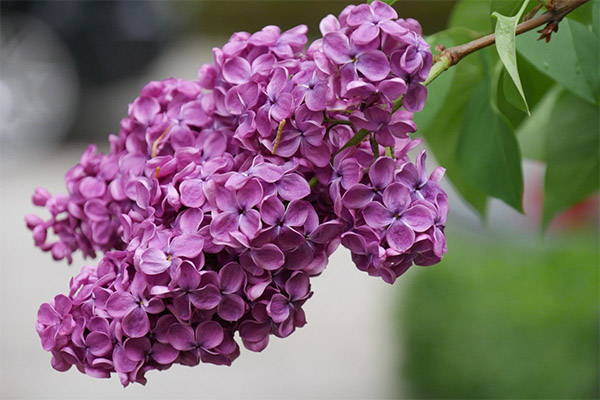
To make this cold dessert, you will need:
- 100 g of fresh lilac flowers;
- 250 ml of milk with a fat content of 3.2%;
- 250 ml of cream;
- 150g granulated sugar;
- 2 tablespoons of maple syrup.
Wash and thoroughly dry the lilac flowers. In a saucepan pour milk and cream, add sugar. Bring to a boil, over low heat. Stir in the lilacs. Take it off heat, cool it down and leave it in a fridge for 24 hours. At the end of the specified time, whip the mixture in a mixer. Carefully add the maple syrup and put in the freezer for an hour. After that, whip again with a blender and put in the freezer until completely frozen. Tender and fragrant lilac ice cream is ready.
Is lilac jam useful?
In addition to desserts, lilacs are used to make a very useful jam for humans. Regular use of this sweet product helps to improve the immune system, normalize blood pressure, acts as a sedative.
Recipe for a classic lilac jam
Ingredients:
- 500 g of lilac flowers;
- 500 grams of sugar;
- 750 ml of water;
- The juice of a lemon.
Pour pre-washed lilac flowers in cold water. Place on a low heat, bring to a boil, then simmer for another 10 minutes. Remove from heat. Add lemon juice. Leave to infuse for half an hour. Then strain the liquid, add the sugar and simmer for 20 minutes over low heat, stirring all the time. Pour the resulting jam in jars. Store in the refrigerator.
Can we give lilacs to rabbits?
Such animals as rabbits, it is strictly forbidden to give any part of the lilacs as food. The fact is that it contains toxic substances that can not only harm the eared representative of fauna, but even lead to his premature death.
Contraindications to use
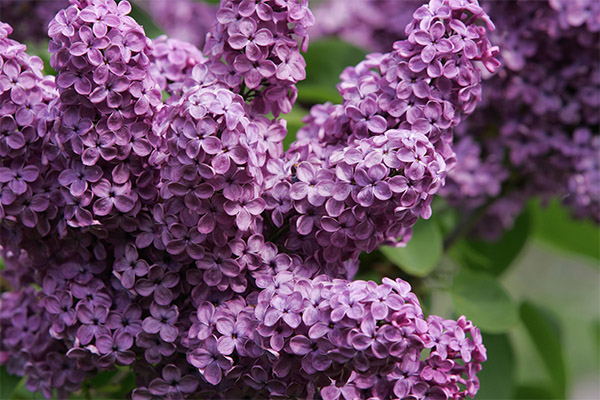
Despite all of the above useful properties of lilac, like many plants, it can also have a negative effect on the human body. There are a number of diseases in which it is not recommended to use in the treatment of means, which include lilac. These include:
- Renal failure, especially in the acute stage;
- Pregnancy and lactation;
- Hormonal failure, as well as menstrual disorders in women;
- Menopause (with special care);
- individual intolerance;
- allergic reaction;
- children's age.
In addition, it is necessary to remember that there are poisonous substances in the composition of lilac. When treating with the help of this plant, you should always follow the exact dosage prescribed by a proven and competent herbalist. You should not violate these prescriptions. Otherwise, you can earn not only poisoning, but also cause more serious damage to the whole body. After all, more does not mean better.
«Important: All information on this site is provided solely for introductory purposes only. Consult with a specialized doctor before applying any recommendations. specialist before you use any of the recommendations. Neither the editors nor the authors shall be liable for any possible harm caused by materials."

